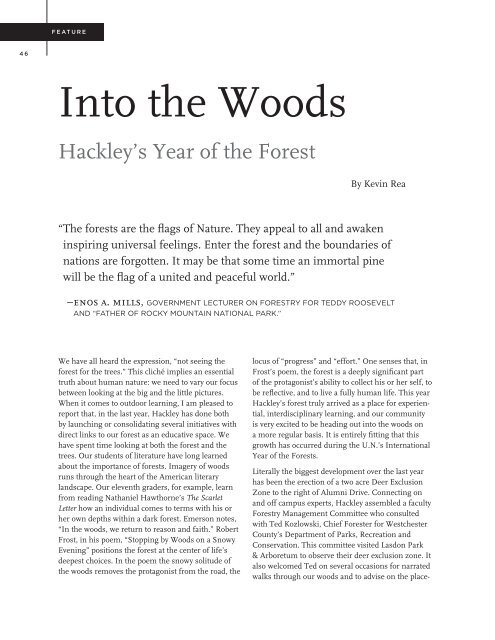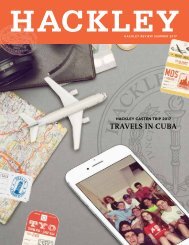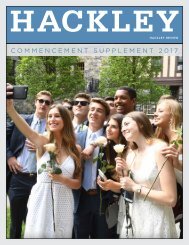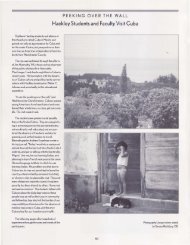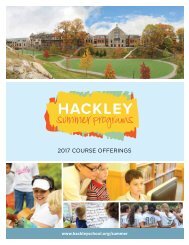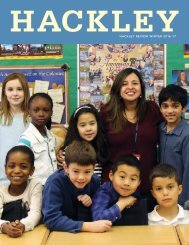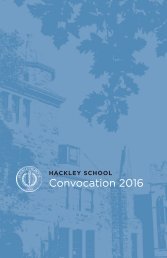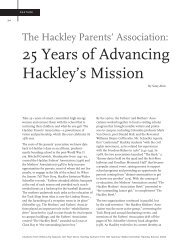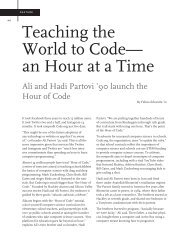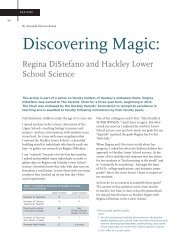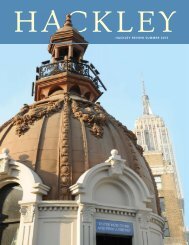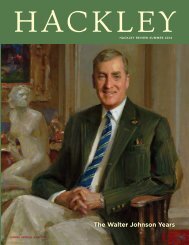You also want an ePaper? Increase the reach of your titles
YUMPU automatically turns print PDFs into web optimized ePapers that Google loves.
Feature<br />
46<br />
Into the Woods<br />
<strong>Hackley</strong>’s Year of the <strong>Forest</strong><br />
By Kevin Rea<br />
“The forests are the flags of Nature. They appeal to all and awaken<br />
inspiring universal feelings. Enter the forest and the boundaries of<br />
nations are forgotten. It may be that some time an immortal pine<br />
will be the flag of a united and peaceful world.”<br />
–enos a. mills, government lecturer on forestry for Teddy Roosevelt<br />
and “FATHER of Rocky Mountain National Park.”<br />
We have all heard the expression, “not seeing the<br />
forest for the trees.” This cliché implies an essential<br />
truth about human nature: we need to vary our focus<br />
between looking at the big and the little pictures.<br />
When it comes to outdoor learning, I am pleased to<br />
report that, in the last year, <strong>Hackley</strong> has done both<br />
by launching or consolidating several initiatives with<br />
direct links to our forest as an educative space. We<br />
have spent time looking at both the forest and the<br />
trees. Our students of literature have long learned<br />
about the importance of forests. Imagery of woods<br />
runs through the heart of the American literary<br />
landscape. Our eleventh graders, for example, learn<br />
from reading Nathaniel Hawthorne’s The Scarlet<br />
Letter how an individual comes to terms with his or<br />
her own depths within a dark forest. Emerson notes,<br />
“In the woods, we return to reason and faith.” Robert<br />
Frost, in his poem, “Stopping by Woods on a Snowy<br />
Evening” positions the forest at the center of life’s<br />
deepest choices. In the poem the snowy solitude of<br />
the woods removes the protagonist from the road, the<br />
locus of “progress” and “effort.” One senses that, in<br />
Frost’s poem, the forest is a deeply significant part<br />
of the protagonist’s ability to collect his or her self, to<br />
be reflective, and to live a fully human life. This year<br />
<strong>Hackley</strong>’s forest truly arrived as a place for experiential,<br />
interdisciplinary learning, and our community<br />
is very excited to be heading out into the woods on<br />
a more regular basis. It is entirely fitting that this<br />
growth has occurred during the U.N.’s International<br />
Year of the <strong>Forest</strong>s.<br />
Literally the biggest development over the last year<br />
has been the erection of a two acre Deer Exclusion<br />
Zone to the right of Alumni Drive. Connecting on<br />
and off campus experts, <strong>Hackley</strong> assembled a faculty<br />
<strong>Forest</strong>ry Management Committee who consulted<br />
with Ted Kozlowski, Chief <strong>Forest</strong>er for Westchester<br />
County’s Department of Parks, Recreation and<br />
Conservation. This committee visited Lasdon Park<br />
& Arboretum to observe their deer exclusion zone. It<br />
also welcomed Ted on several occasions for narrated<br />
walks through our woods and to advise on the place-
47<br />
Upper School students inside the Deer Exclusion Zone.<br />
ment of the deer exclusion zone. The Buildings<br />
and Grounds Committee of the Board of Trustees<br />
reviewed and approved the proposed zone at a<br />
meeting in the autumn. For those of you wondering<br />
exactly what a deer exclusion zone is, it is a high<br />
fence (8 feet) erected around an area of the forest<br />
which prevents the deer from grazing (and therefore<br />
eating) the vegetation. As a result of this “exclusion,”<br />
the forest regenerates over time. Ted observes that<br />
in approximately two years our students and faculty<br />
will notice the beginnings of a dramatic rebirth, the<br />
results of which will serve as an invaluable teaching<br />
resource about forest depletion, native versus non<br />
native plant species and deer management techniques.<br />
In commenting on the deer exclusion zone,<br />
Ted writes:<br />
I feel that our suburban forests are under siege from<br />
many influences generated by human activities both<br />
intentional and unintentional. Climate change,<br />
ecosystem disruptions, invasive plants, deer browsing,<br />
pollution, and neglect have created a dire situation<br />
within our native forests. They simply are not regenerating.<br />
The real challenge here is one of education. Today<br />
our young people are growing up believing that the forest<br />
they see outside their window is static. Sadly, teaching<br />
about forest ecology takes a back seat in many school<br />
systems today. The hope lies with dedicated teachers<br />
such as the wonderful people at <strong>Hackley</strong> School who are<br />
taking these challenges and using them as teaching tools<br />
for their students in the hope of instilling a new motivation<br />
in this field. The deer exclusion fence is a great<br />
teaching tool as it will generate immediate results in how<br />
a forest responds when people take action. A forest naturally<br />
regenerating itself is a beautiful thing to see, and it<br />
can be witnessed by the students as they advance through<br />
their years at <strong>Hackley</strong>. The results will astound.<br />
As a result of the close connections inspired by this<br />
project, Ted Kozslowski returned to the Hilltop with<br />
Dan Aitchison from Westchester Parks Conservation<br />
Division, and the two delivered this year’s endowed<br />
Szabo lecture to our Upper School on forestry and<br />
conservation in the region.
48<br />
Upper School Science students learn about <strong>Hackley</strong>’s forest from forestry experts Ted Kozlowski and Dan Aitchison.<br />
Outdoor learning takes many forms, but, as our<br />
faculty will tell you, it helps to have an identifiable<br />
teaching space in which to work. Another outdoor<br />
innovation is the creation of <strong>Hackley</strong>’s new Outdoor<br />
Classroom. It sits adjacent to the Deer Exclusion Zone<br />
and “Spring Peeper Pond.” Originally a joint initiative<br />
by the English and Science departments, the Outdoor<br />
Classroom now provides a picturesque setting for<br />
poetry readings, science discussions and more in the<br />
middle of the forest. Students in Spanish 4 classes<br />
have enjoyed learning outdoors in the autumn during<br />
which they conversed about the forest. After writing<br />
compositions based on outdoor classroom lessons,<br />
they studied photographs by Robert Glenn Ketchum<br />
and wrote descriptions of his magnificent images<br />
in the book The Hudson River and the Highlands. As<br />
a year round learning space the classroom provides<br />
students the chance to see the red and yellow hues<br />
of autumnal sugar maples, the ice covered logs and<br />
snow in the winter as well as the blooming flowers<br />
and plants in the spring. Students and faculty are<br />
rediscovering the natural rhythms of the seasons as<br />
they watch them through a variety of academic lenses.<br />
Renowned wildlife tracker Susan Morse from<br />
Keeping Track added to our students’ sense that the<br />
forest is alive. Visiting as part of the Upper School’s<br />
Earth Day activities this April, she spoke to our<br />
Ecology classes about the role and importance of<br />
predators in our forests (both native mammals and<br />
humans). In addition, she led two field trips into our<br />
woods. In her first field trip she pointed out non-vocal<br />
animal communication and signs, and in her second<br />
trip she helped students and faculty get a sense of the<br />
human impact on the forest, its history, and a broader<br />
understanding of general forest ecology issues.<br />
Susan is writing a summary of her brief survey of our<br />
woods, pointing out how we can improve our woods<br />
for native wildlife. Our Science Department hopes to<br />
use this as a supplemental text with our Ecology class.<br />
Susan was most impressed with our deer exclusion<br />
zone which she thought was the best educational tool<br />
in our forest.<br />
Our Science Department is leading the way with<br />
linking the forest to curriculum by bringing students<br />
in the Lower, Middle and Upper Divisions outdoors<br />
to engage in a variety of studies. Students in Tessa<br />
Johnson’s Advanced <strong>Forest</strong> Ecology Research (AFER)<br />
classes actively learn from the forest. Andy Retzloff’s<br />
Biology classes also head outdoors frequently. Other<br />
Science classes in grades 5-7 enjoy opportunities to<br />
get outdoors. The AFER classes made a field notebook<br />
that has over one hundred species in it of organisms<br />
seen in our forest. These are extraordinary notebooks<br />
about which the students are most proud by the end
49<br />
Clockwise from above: An Upper School class in the<br />
outdoor classroom. One of the educational signs in<br />
<strong>Hackley</strong>’s forest. Mr. Retz and pal—the “scarecrow”<br />
actually serves as a feeder for birds, who gradually<br />
learn to trust the human form and come to feed from<br />
students’ hands.<br />
of the course. The most popular study is the salamander<br />
study begun in the fall of 2009. Students<br />
then placed one hundred boards in an area 10m by<br />
100m. Every spring and fall these boards are checked<br />
as least twice a month for salamanders. The species<br />
of salamanders are identified and measured. If they<br />
are red back salamanders, students determine what<br />
color morph they are—red back or lead back. The last<br />
two years the AFER classes have worked with the<br />
kindergarten classes by giving them a presentation<br />
that includes an introduction to the forest. These<br />
same students also take our Lower School students<br />
out and teach them how to participate in the study.<br />
This year we have begun to lay out boards in the deer<br />
exclusion zone adjacent to the current area of study.<br />
In the future classes will have fifty boards out with<br />
another fifty planned soon thereafter. The department<br />
hopes to compare the abundance of salamanders<br />
inside and outside the deer exclusion zone. Students<br />
also measure water quality in the spring time. Deer<br />
Pond and Peeper Pond are sampled twice a month.<br />
Students measure, circumference, depth, temperature,<br />
pH, dissolved oxygen, nitrate and alkalinity.<br />
The Science department has also established a bird<br />
feeding station. Here our students count the total<br />
number of each species of birds seen at one time in<br />
rain, snow or sun. Students are currently monitoring<br />
“Getting the opportunity to regularly engage<br />
with and learn about our natural resources<br />
has been a really great opportunity for me this<br />
past year. The hands on learning we’ve done<br />
is unparalleled and invaluable.”<br />
—A.L. Schwalb, Class of <strong>2012</strong><br />
“Being in the woods is both physically eye<br />
opening to see all of the birds that fly around<br />
but it’s also emotionally eye opening to just<br />
think that a few yards from that classroom<br />
is a whole new world where something new<br />
is discovered every day.”<br />
—Alex Katsihtis, Class of 2013<br />
“I am a senior, and before this year I had never<br />
even been in the <strong>Hackley</strong> woods before. To<br />
go out into the woods is such an amazing thing<br />
that <strong>Hackley</strong> has to offer, and has been such<br />
a learning experience.”<br />
—Ali Kaminetsky, Class of <strong>2012</strong>
Feature<br />
50<br />
A <strong>Hackley</strong> trail marker.<br />
Right: Middle School students<br />
at Deer Pond.<br />
bluebird nest boxes nearby. By the time this <strong>Hackley</strong><br />
<strong>Review</strong> is published, the Science Department is planning<br />
to have erected nature trail information signs on<br />
the Carl Buessow nature trail. These signs were originally<br />
created as a senior project. The department has<br />
also begun working closely with the Math department<br />
and our Statistics students to analyze the data being<br />
collected in the forest. Active forest visits also extend<br />
to our Middle School students. The fifth grade begins<br />
their science year learning to identify tree species on<br />
campus, along with a little of their natural history and<br />
ecology. For several years they have celebrated Earth<br />
Day by planting their own conifer trees on campus.<br />
This year they planted White Spruce trees, as we were<br />
finding that the White Pine we usually plant were<br />
being eaten by our ever expanding deer population.<br />
Many fifth and sixth grade students also participant in<br />
the popular “ASK” (After School Knowledge) nature<br />
program where the theme is getting the kids into the<br />
<strong>Hackley</strong> woods for exploration and, just as important,<br />
play. Lower School students also head outdoors,<br />
accompanied by our Upper Schoolers as part of<br />
their Ecology class. Members of our Upper School<br />
<strong>Hackley</strong> Earth Action League (HEAL) also led many<br />
workshops on climate change awareness this year.<br />
One of the areas of focus was on deforestation.<br />
This focus on forestry and outdoor education<br />
occurs at an exciting time with <strong>Hackley</strong>’s acceptance<br />
as a Regional Member of Round Square<br />
(www.roundsquare.org). One of the “Six Ideals” of<br />
Round Square is focus on the Environment. The<br />
Round Square website states that at Round Square<br />
schools “students are taught the fine balance and<br />
the interdependence needed to maintain a healthy<br />
relationship between human beings and the planet.<br />
Special programs, work projects and curricula all<br />
emphasize each young person’s destiny to be a<br />
guardian of human society and the global environment.”<br />
The growing interest in our forest is part of<br />
the evolving ways we prepare students to face the<br />
challenges of a globally interconnected world in this<br />
young century. The Community Studies Department,<br />
a new academic department launched in the<br />
2011–<strong>2012</strong> academic year, has kept the forest firmly
51<br />
Above: Andy Retzloff works with Middle School students at Deer Pond.<br />
Below: Deer Exclusion fence.<br />
in its sights as it plans future academic course offerings.<br />
It recently introduced a new elective focusing<br />
on water and environmental education. “Water<br />
Works” is a course that is open to all Upper School<br />
students and which finds a home in the departments<br />
of Community Studies, Science and English. It will<br />
introduce our students to experiential learning about<br />
the planet’s resources including water and trees.<br />
Our forest is deeply linked to <strong>Hackley</strong>’s educational<br />
mission, and the increasing interest in interdisciplinary<br />
studies, environmental awareness,<br />
international engagement, service, democracy, adventure<br />
and leadership remind us that the way students<br />
learn is continuing to change to embrace an active,<br />
experiential component. The road less travelled has<br />
become much more significant (and well travelled)<br />
as <strong>Hackley</strong> prepares students to live independently<br />
in the world.<br />
Kevin Rea is an Assistant Headmaster at <strong>Hackley</strong><br />
and Chair of the newly created Community<br />
Studies Department.


